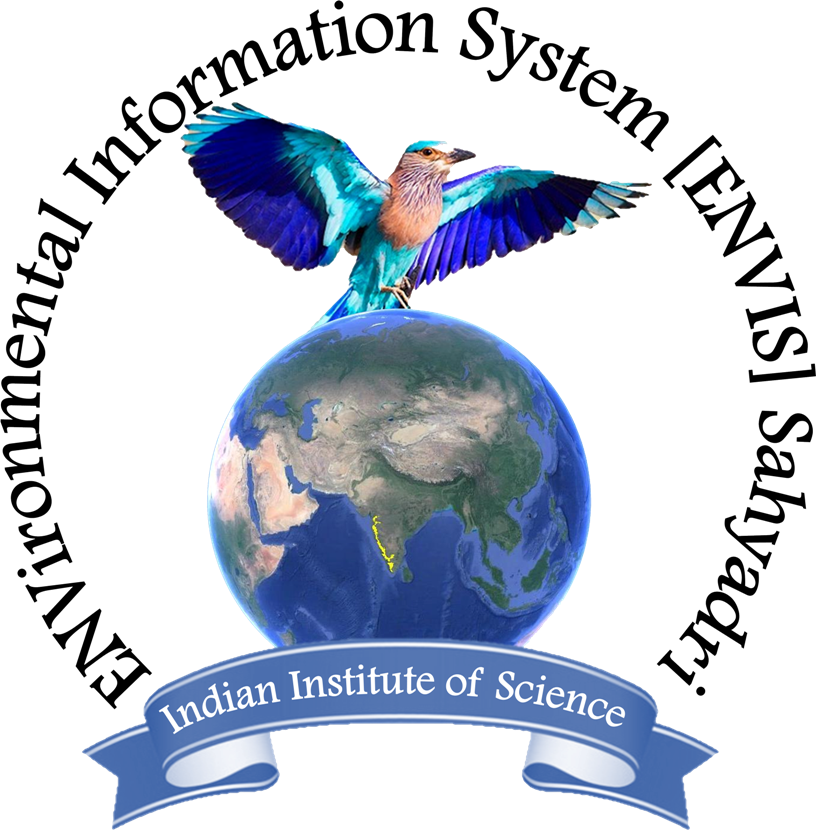Rejuvenation & Sustainable Management of Gokarna Temple Pond - KotiteerthaCite
Ramachandra T V, Durga Madhab Mahapatra, Subash Chandran M D, Sincy V, Asulabha K S, Rao, G R, Vishnu D. Mukri, Akhil C A
ENVIS[RP], Environmental Information System, Energy and Wetlands
Research Group,
Centre for Ecological Sciences, Indian Institute of Science -
560012
envis.ces@iisc.ac.in
tvr@iisc.ac.in Phone:
080 22933099/22933503
Results and Discussions
Water Quality Analysis
- Dissolved Oxygen: Dissolved oxygen (DO) is the most essential parameter in the aquatic ecosystems as it helps in the aquatic respiration as well as detoxification of complex organic and inorganic mater through oxidation. However, the sustained disposal of organic materials after rituals can impose a very high oxygen demand leading to oxygen depletion with severe impacts on the water ecosystem. The temple debris and the left out matter from the cultural practices can impart significant amount of oils, volatile organics, nutrients and solids in the pond. The DO of the analysed water samples varied between 2.7 (site 1) to 11.3 ppm (site 3). The higher variations of DO especially lower DO values are indicative of fast oxidising chemicals/bacterial activity in the ecosystem. Lower values of DO highlight the impact of disposing organic materials (such as rice balls, flower, etc.) in the pond. The shallower region (site-3) showed the highest DO levels indicating less abuse of the place compared to other sites.
- Total Dissolved Solids (TDS): TDS affect the water quality in many ways impacting the water usage for domestic (drinking, cleaning, bathing, etc.). Total dissolved solids originate from organic sources such as leaves, silt, plankton, organic debris and also from sewage. Other sources come from runoff from nearby areas (APHA, 2000). Surface as well as groundwater with high dissolved solids are of inferior flavour and induce an unfavourable physiological reaction to the dependent population. TDS values in the samples analyzed, ranged from 38.5 to 41 ppm across all locations. It was higher at site 2, where disposal of organic materials is higher. TDS was comparatively high at locations with higher human activities such as washing of utensils, disposing rituals organic materials (rice balls, etc.).
- pH: pH is a numerical expression that indicates the degree to which water is acidic or alkaline, with the lower pH value tends to make water corrosive and higher pH has negative impact on skin and eyes. pH value of water samples of the pond are acidic and ranged from 5.8 - 6.1. A slightly lower pH value can be attributed to either the humic and fulvic acids (high detrital matter) or due to the volatile organic acids emanating from the decomposing and semi decomposed organic materials (of rituals). Also, aquatic macrophytes that were cut were left in the shallow region of the pond and with decomposition it is emanating low molecular weight organic acids.
- Turbidity: Turbidity indicates the amount of suspended matter that are of a colloidal dimension. All water samples showed a very low turbidity indicating no suspended micro algae. The values ranged from 1.69 (site 3) to 4.81 NTU (site 2). Slightly higher values at site 2 is due to the disposal of organic materials after ritual.
- Chlorides: Chlorides are essentially potential anionic radical and excess of chlorides leads to the formation of potentially carcinogenic and chloro-organic compounds. Chloride values in samples ranged from a mere 22.72 - 24.14 ppm. Relatively higher values were observed in sites 2 and 3. It may be due to washing (cloth and utensils) with bleaching powder or chloride detergents.
- Sodium: Sodium (Na) is one of the essential cations that stimulate various physiological processes and functioning of nervous system, excretory system and membrane transport in animals and humans. Increase of sodium ions has a negative impact on blood circulation, nervous coordination, hence affecting the hygiene and health of the nearby localities. The concentration of sodium in the pond water samples were low and ranged from 21.6 (site 2 and 3) to 22.8 ppm (at the deeper reaches, site 1). Sodium values were significantly correlated with chlorides (r= 0.99; p<0.0001) and Ca Hardness ((r= 0.99; p<0.0001).
- Potassium: Potassium (K) is an essential element for both plant and animal nutrition, and occurs in ground waters as a result of mineral dissolution, decomposing of plant materials and also from agricultural runoff. Potassium ions in the plant root systems helps in the cation exchange capacity to transfer essential cations like Ca and Mg from the soil systems into the vascular systems in the plants in replacement with the potassium ions (Mahapatra et al., 2011a). Incidence of higher potassium levels in soil system affects the solute transfer (active and passive) through the vascular conducting elements to the different parts of the plants. The potassium content in the water samples of Gokarna tank ranges between 3.2-4.8 ppm. Higher potassium values were at disturbed regions (site 2) due to the sustained disposal of organic materials (of rituals).
- Alkalinity: Alkalinity is a measure of the buffering capacity of water contributed by the dynamic equilibrium between carbonic acid, bicarbonates and carbonates in the water. Sometimes excess of hydroxyl ions, phosphate, and organic acids in water causes alkalinity. High alkalinity imparts bitter taste. The acceptable limit of alkalinity is 200 ppm. The alkalinity of the samples ranges from 64 - 76 ppm. A comparatively higher value was observed in site 2 owing to the disposal of organic materials (rice balls, flowers, etc.) after performing rituals.
- Total hardness: Hardness is the measure of dissolved minerals that decides the utility of water for domestic purposes. Hardness is mainly due to the presence of carbonates and bicarbonates. It is also caused by variety of dissolved polyvalent metallic ions predominantly calcium and magnesium cation although, other cations like barium, iron, manganese, strontium and zinc also contribute. In the present study, the total hardness ranged between 22 to 24 ppm. It was relatively high at site 2. Hardness is significantly correlated with the EC values (r= 0.9; p<0.05).
- Calcium hardness: Calcium (Ca) is one of the major macro nutrients which are needed for the growth, development and reproduction of both plants and animals. The presence of Ca in water is mainly due to its passage through deposits of limestone, dolomite, gypsum and other gypsiferous materials (APHA, 2000). It contributes to the total hardness of the water. Ca hardness concentration in the samples analysed varied from 3.74 to 4.81 ppm.
- Magnesium hardness: Magnesium (Mg) in one of the most essential macro nutrients that helps as a co-factor in the enzyme systems and in the central metal ions that constitutes the chlorophyll molecule essential for plant photosynthesis. According to WHO guidelines the maximum admissible limit is 50 ppm. In this study the concentration of magnesium hardness ranged from 4.18-4.66 ppm. Mg hardness was significantly correlated with turbidity (r= -0.9; p<0.05).
- Nutrients (nitrates and phosphates): Nutrients essentially comprise of various forms of N and P which readily dissolve in solutions that are uptaken in the form of inorganic mineral ions by plant root systems through microbes. Accumulation of N (as nitrates) and P (as inorganic P) in aquatic ecosystems leads to higher net productivity causes with significant water quality problems. Sustained input of organic materials (of rituals consisting of large quantity of rice balls, banana, flower, etc.) beyond the supportive and assimilative capacities of the pond has resulted in nutrient enrichment and profuse growth of invasive floating plant species. Together with phosphorus, nitrates in excess amounts in streams and other surface waters can accelerate aquatic plant growth causing rapid oxygen depletion or eutrophication in the water. Nitrates at high concentrations (10 mg/l or higher) in surface and groundwater used for human consumption are particularly toxic to young children affecting the oxygen carrying capacity of blood cells ( RBC) causing cyanosis (methemoglobinemia). In the present study, nitrate values ranged from 0.15 to 0.23 ppm. Nitrate values were significantly correlated with TDS (r= -0.9; p<0.05). The phosphate values ranged between 0.2 to 0.4 ppm. Ponds with phosphate values >0.02 ppm have been reported as eutrophic in nature.
- BOD and COD: BOD and COD are important parameters that indicate contamination with organic wastes. Biochemical oxygen demand (BOD) is the amount of oxygen required by bacteria while stabilizing decomposable organic matter under aerobic. These parameters help to assess the extent of pollution of surface and ground water where contamination occurred due to the organic inputs (of rituals) to the pond. Figure 3.1 indicates the type of activities around the pond.


Figure 3.1 a) organic materials (rice balls, etc.); b) washing of utensils in the pond
Chemical oxygen demand (COD) determines the oxygen required for chemical oxidation of most organic matter and oxidisable inorganic substances with the help of strong chemical oxidant. In conjunction with the BOD, the COD test is helpful in indicating toxic conditions and the presence of biologically resistant organic substances (Sawyer and McCarty 1978). In this study the BOD values ranged from 4.07-8.13 ppm. BOD values were negatively correlated with EC values (r= -0.9; p<0.05). The COD values ranged from 12 to 24 ppm. The COD were relatively high at site 2. The ORP values indicate highly oxidising conditions in the temple pond. The physicochemical analysis of the select sampling sites is elucidated in Table 3.1.
Table 3.1 Physicochemical parameters of water samples from select sampling locations
Parameters \ Sampling Locations |
Site-01 |
Site-02 |
Site-03 |
Sam-Label |
867 |
868 |
869 |
Time |
11:00 |
11:40 |
12:30 |
Latitude (oN) |
14.54156 |
14.54139 |
14.54119 |
Longitude (oE) |
74.31965 |
74.31973 |
74.32137 |
Altitude (meter above msl) |
7 |
6 |
1 |
pH |
5.9 |
5.8 |
6.1 |
Temp (oC) |
33 |
35.6 |
31.3 |
TDS (ppm) |
38.5 |
41 |
38.8 |
Sal (ppm) |
27.8 |
30.7 |
28.7 |
EC (mic.S/cm) |
55.6 |
58 |
55.5 |
ORP (mV) |
158 |
164 |
166 |
Turbidity (NTU) |
3.45 |
4.81 |
1.69 |
DO (ppm) |
2.70 |
5.00 |
11.3 |
BOD (mg/l) |
8.13 |
4.07 |
8.13 |
COD (mg/l) |
16 |
24 |
12 |
Alkalinity (mg/l) |
68 |
76 |
64 |
Chloride (mg/l) |
22.72 |
24.14 |
24.14 |
Total Hardness (mg/l) |
22 |
24 |
22 |
Ca Hardness (mg/l) |
3.74 |
4.81 |
4.81 |
Mg Hardness (mg/l) |
4.44 |
4.66 |
4.18 |
Phosphate (mg/l) |
0.211 |
0.243 |
0.41 |
Nitrate (mg/l) |
0.23 |
0.146 |
0.217 |
Sodium (mg/l) |
21.6 |
22.8 |
22.8 |
Potassium (mg/l) |
3.2 |
4.8 |
4 |
-
- Macrophyte diversity and abundance
During the site visit it was observed that ~70 % of the temple pond surface was covered by macrophytes and to minor extent filamentous algae. The extent and spread of macrophytes was higher in the shallower regions of the pond. Eleven macrophytes species (Table3.2) were recorded during the field investigation.
Table 3.2: Macrophytes of Gokarna temple pond
No. |
Macrophytes |
||
1 |
Valisneria spiralis |
||
2 |
Nymphae nouchali |
||
3 |
Nymphae pubescens |
||
4 |
Ceratophylum demersum |
||
5 |
Limnophylla heterophylla |
||
6 |
Limnophylla aromatica |
||
7 |
Rotala macranadra |
||
8 |
Ceraptoteris thalictroides |
||
9 |
Utricularia gibba |
||
10 |
Blyxa aubertii |
||
11 |
Nymphoides sp. |
||
Macrophytes observed in the pond are i) submerged floating leaf type e.g. water lily etc., and ii) submerged e.g. Ceratophyllum, Blyxa, Valisneria. Macrophytes specimen were collected through opportunistic sampling from accessible parts of the pond. Most of the samples were collected either by hand or with the help of a wooden pole. Macrophytes near the shallow regions were trapped between filamentous cyanophycean members as Oscillatoria and Pseudoanabaena.
The proliferation of macrophytes in the ponds highlights of nutrient enrichment and internal recirculation of nutrients especially P from the dead and decaying plant matter, organic inputs of rituals and nutrient laden sediments. Deposition and decay of organic matter has contributed to the foul odour. Higher macrophyte density also indicates of increased primary productivity due to nutrient enrichment both from autochthonous and allochthonous sources, which eventually leads to conversion of ponds into swamps and marshes. No emergent macrophytes were recorded during the site inspection. Macrophytes recorded at sampling locations are Site 1, corresponding to deeper part of the pond comprised of Nymphae and Limnophylla species. Site 2, mainly comprised of Lymnophylla, Nymphae and Nymphoides species and Site 3 with the higher macrophyte diversity (Figure 3.2c and d). Water lily is the dominant macrophytes in the deeper reaches where as plants like Valisneria and Ceratophyllum along with that Nymphae, Limnophylla and Blyxa species were dominant in the shallower reaches. Decomposed plant debris (uprooted and dead Valisneria species) and organic inputs (of ritual) have contributed to foul odour as well as lowering of DO that might eventually harm the entire aquatic biota. The large floating leafs of lily provides aesthetic looks to the pond but at the same time their over growth acts as an obstacle in light penetration, that is detrimental to the submerged algae or macrophyte community and this ultimately results in reduction of the overall dissolved oxygen creating partial anoxia in deeper zones.
During the field investigations, it was observed that Valisneria spiralis domination were mainly confined to the littoral zone (1.5-2.0 m), which had higher transparency and also observed at higher depth (>3 m) locations. This indicates its potential in stabilising the suspended particles and making the water clear. Such type of tropical pond systems with submerged plants like Valisneria spiralis have the potential to maintain clarity of the water through out the year. These submerged species restricted suspended algal growth, even though the nutrients levels and the organic loads were slightly high. Higher phosphates (0.2 - 0.4 mg/l; i.e. > 0.02 mg/l) value indicates an eutrophic status of the lake. Figure 3.2 depicts the extent and spread of macrophytes communities in the temple pond. Figure 3.3 elucidates sampling location wise, the percentage composition/distribution of macrophytes in the lake. Macrophyte specimen collected are depicted in figure 3.4.








Figure 3.2 a)-d): distribution and types of macrophytes in various sampling lications and
e)-f): the extent of macrophyte proliferation in the temple pond
g) Nemachilichthys ruppelli and h) Common carp - fishes found in temple pond

Figure 3.3 a) percentage cover of macrophyte species in pond
b)-d) percentage composition of macrophytes at sampling locations (Sites 1-3)





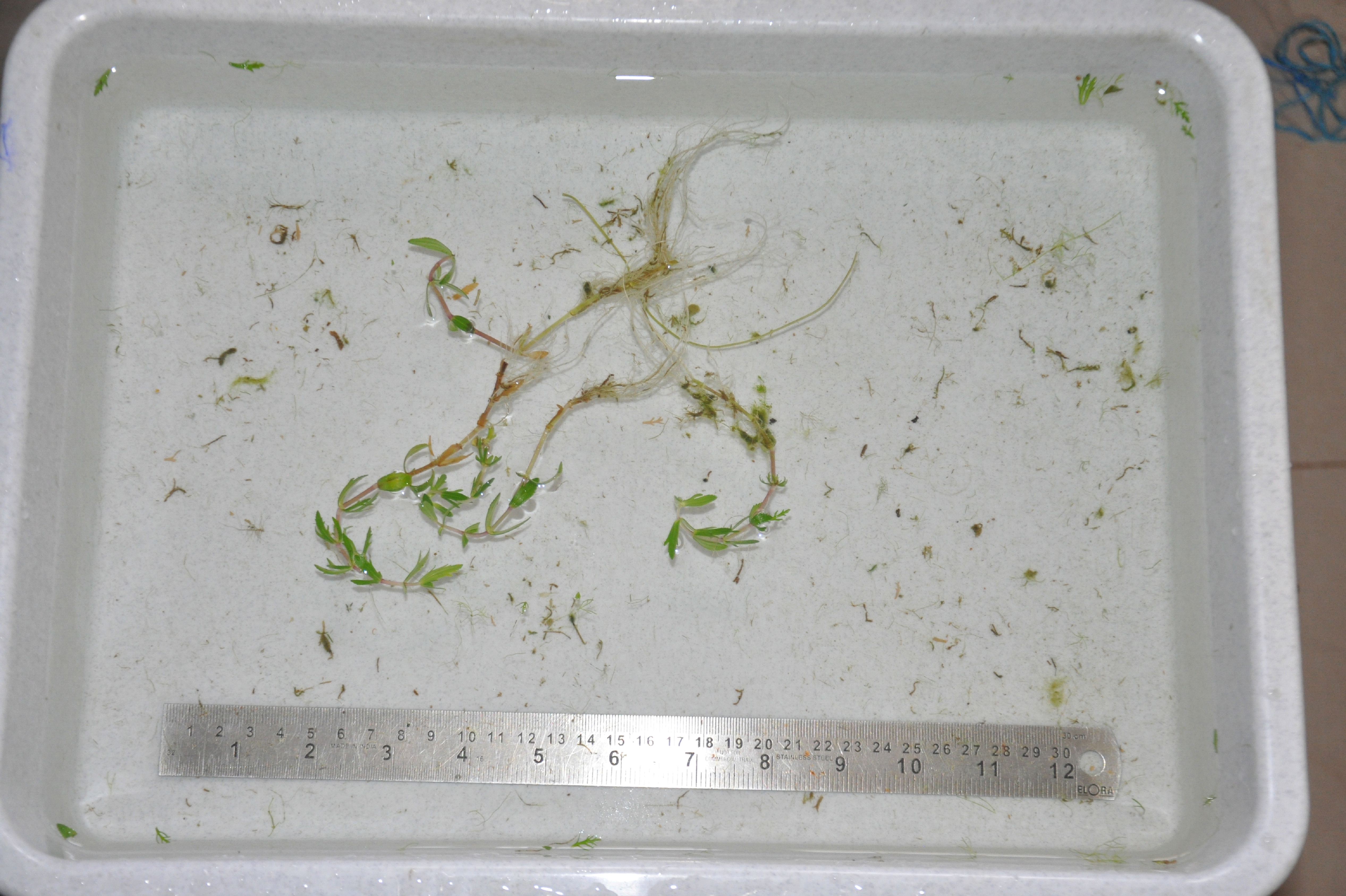
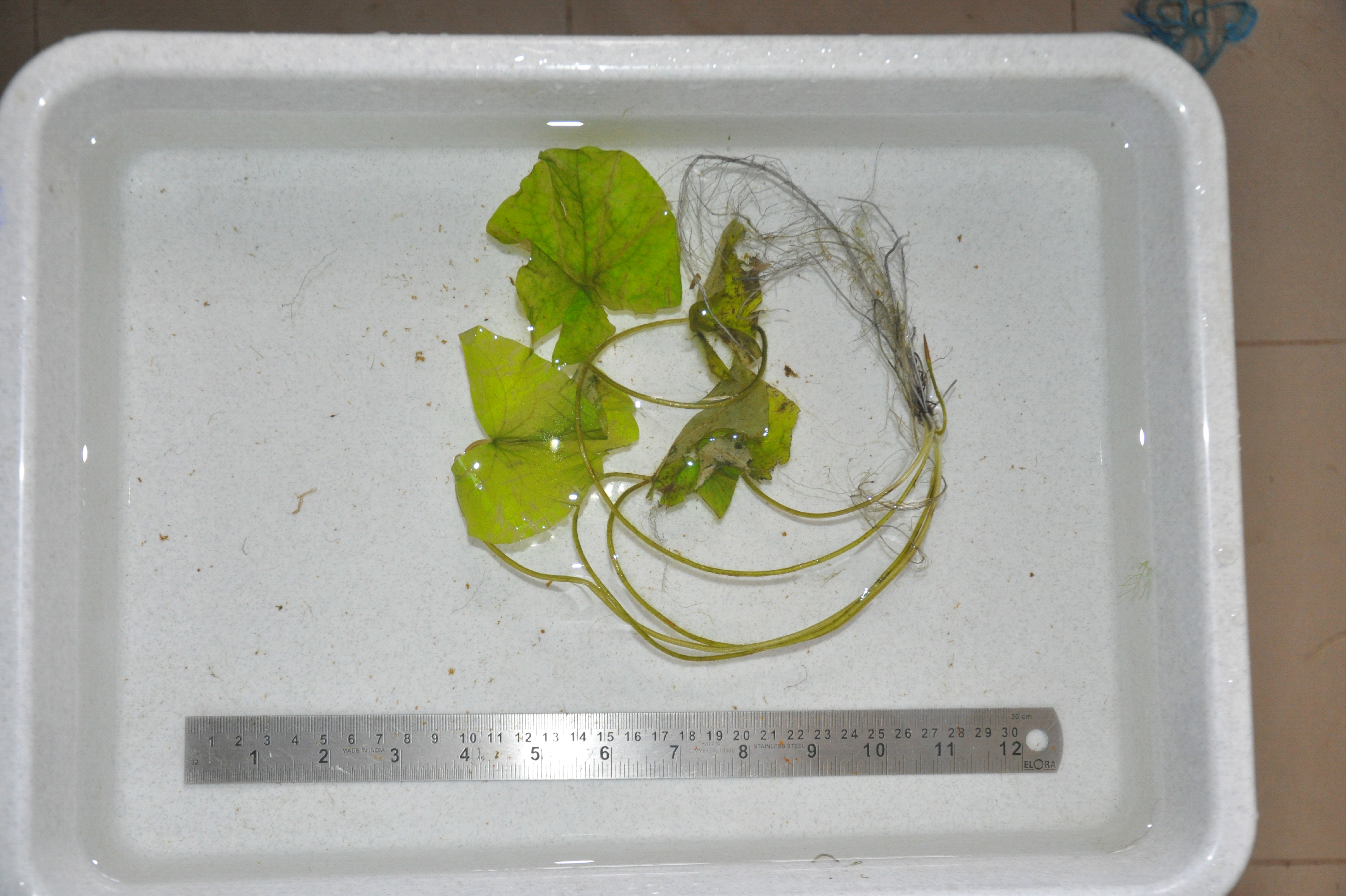
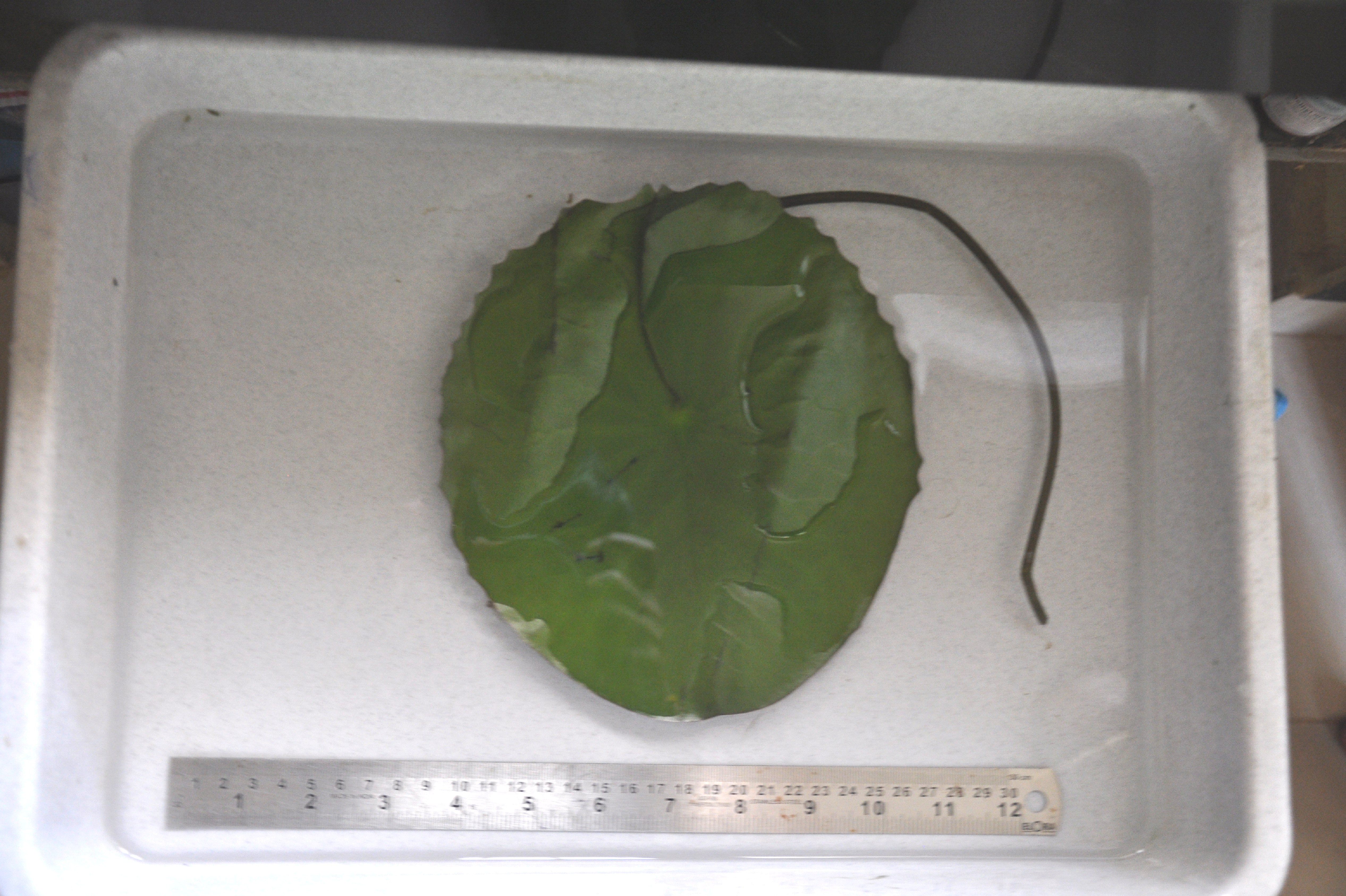
Figure 3.4: Macrophyte specimen - a) Ceratophylum demersum b) Ceraptoteris thalictroides c) Valisneria spiralis d) Rotala macranadra e) Limnophylla heterophylla f) Limnophylla aromatica g) Nymphoides sp. h) Nymphae nouchali
- ALGAL ANALYSIS
Analysis of macrophytes samples with the help of standard morphological keys indicate the presence of 24 algal species (Table 3.3) belonging to four taxonomic divisions, Cyanobacteria (1), Bacillariophyta (6), Chlorophyta (14), and Euglenophyta (3). Sampling location wise, algal species are:
- Site 1 recorded the highest diversity (>16 species) and majority were green algae (10). In all the three sites the chlorophycean members dominated over the members of other classes. These include Cosmarium spp., Kirchneriella spp., and Staurastrum spp.
- Site 2 has higher diversity of the euglenophycean members and the bacillariophycean members, attributable to the presence of higher organic matters that correlates with the higher COD and TDS values. Abundance of eugleophytes is an indication of the nutrient enrichment with the input of higher organic matter. These include chrolophycean members the Staurastrum spp.
- Site 3 with higher DO values has more than 12 algal sp. and were dominated by Xanthidium sp. (which are absent in the other sampling sites).
Apart from these macro algal species were also identified and analysed (figure 3.5-3.7). Figure 3.8 elucidates the composition - green algae (~58 %) diatoms (25 %) > euglenophytes (13 %) > blue green algae (4 %) during the study. Figure 3.9 provides select algal microscopic illustrations.
Filamentous macro algae in the peripheries of the pond were Oscillatoria sp. This species were mostly found along with organic debris and sludge masses floating on the top trapping air bubbles and are the most common bloom forming algae in the nutrient enriched waters. Most interestingly these species were also observed entangling the aquatic hydrophytes like Vallisneria spiralis, due to which the long leafs of the plant were bundled together, obstructing sunlight that inhibit photosynthesis. Further more the submerged aquatic plants also uptake nutrients through leafs, and the presence of dominant cyanophycean members such as Oscillatoria hampers the growth and productivity. Pseudoanaebaena species were also observed associated with some of the Oscillatoria clumps near the shore lines.
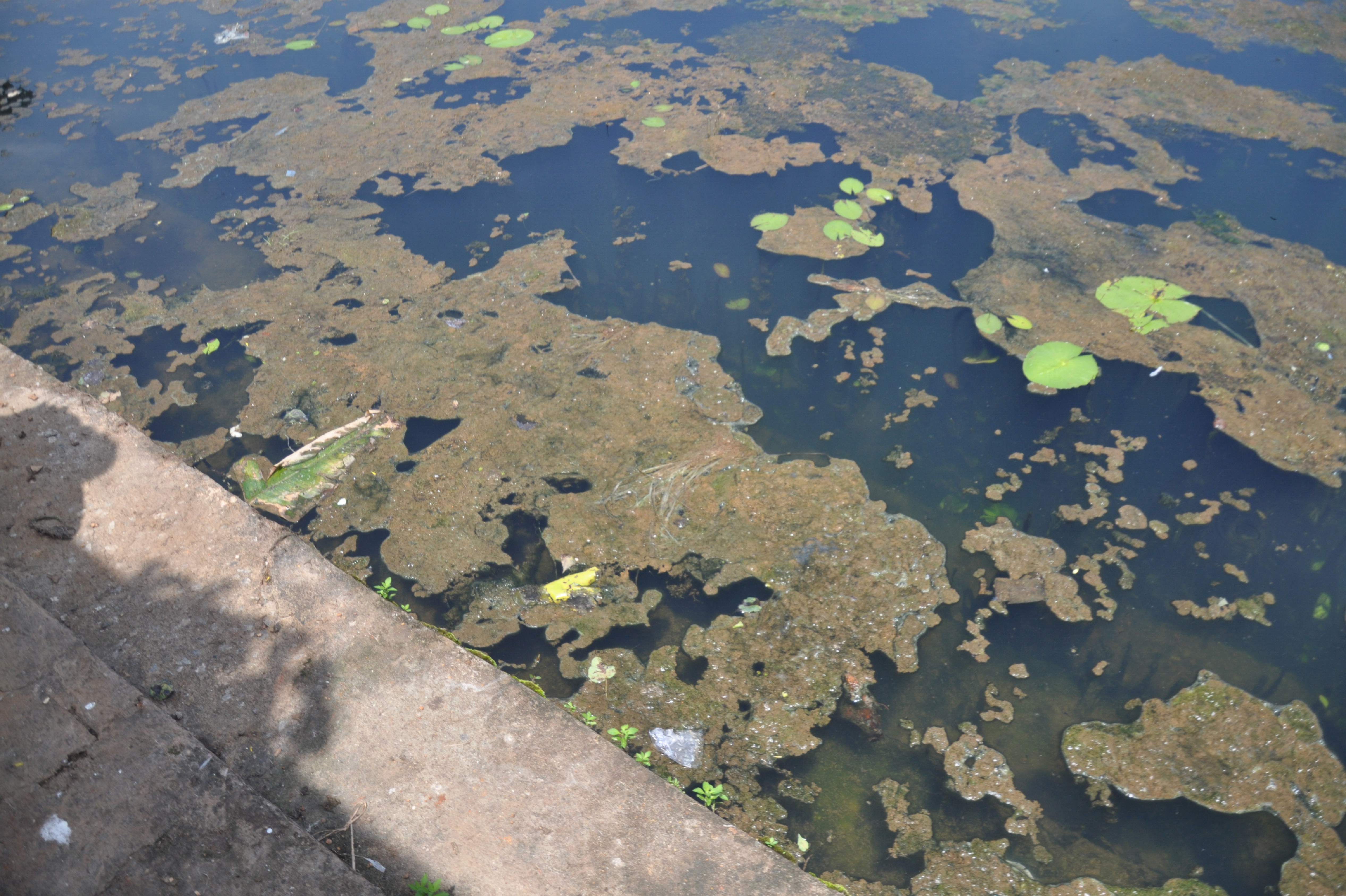
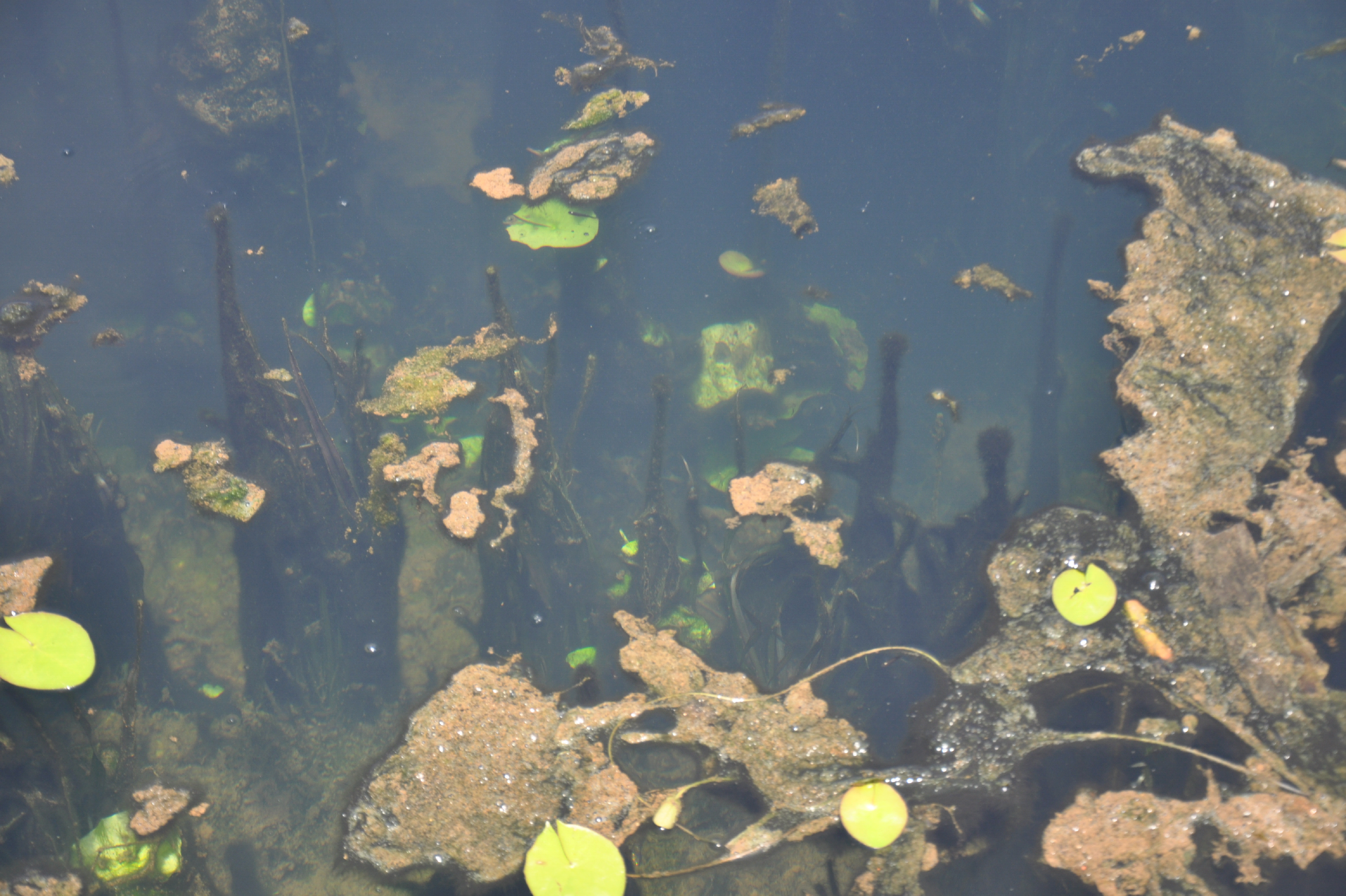
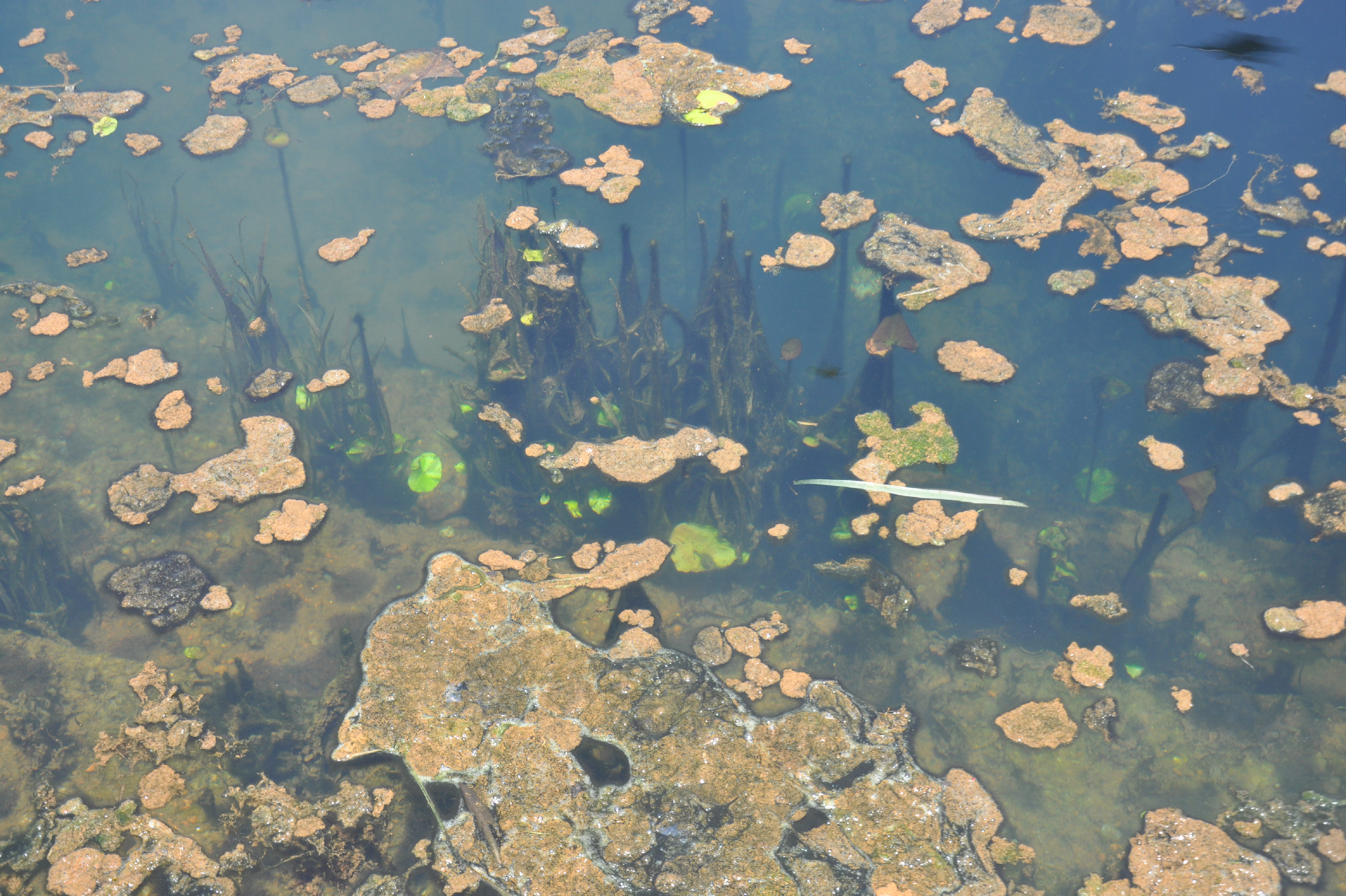
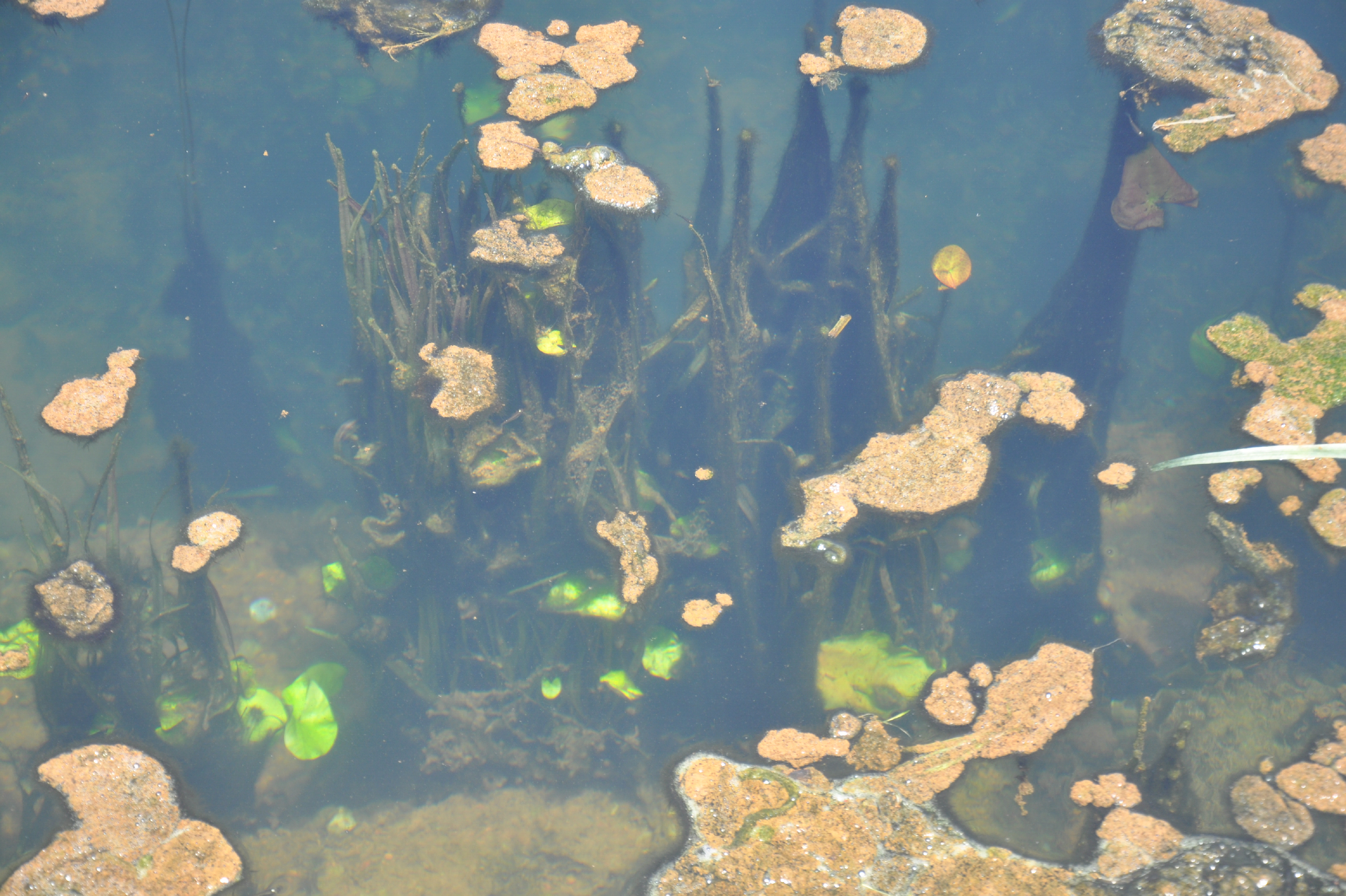
Figure 3.5: Filamentous Cyanophyceae attachments with Valisneria sp.
The surface of the pond in the deeper regions were mostly occupied by a composite of green algae Spirogyra sp. (known as pond silk), water lily with intermittent Limnophylla sp. This forms a network like structure floating on the top of the pond over which small Utricularia sp. flowers were observed. This mesh restricts the penetration of sunlight and might also limit air diffusion creating problem to the fish and aquatic biota (Figure 3.7).
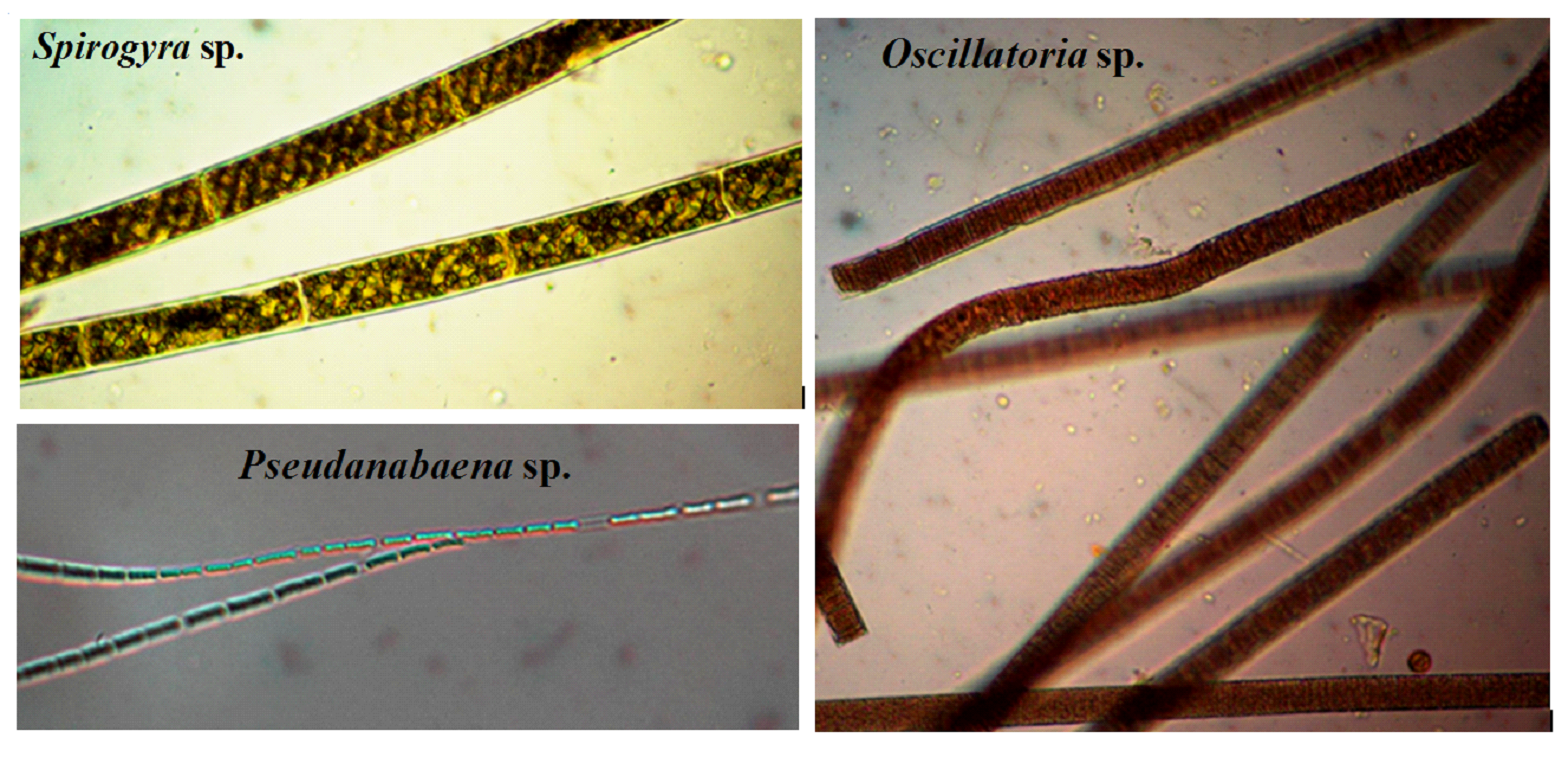
Figure 3.6: Filamentous algae in the temple pond
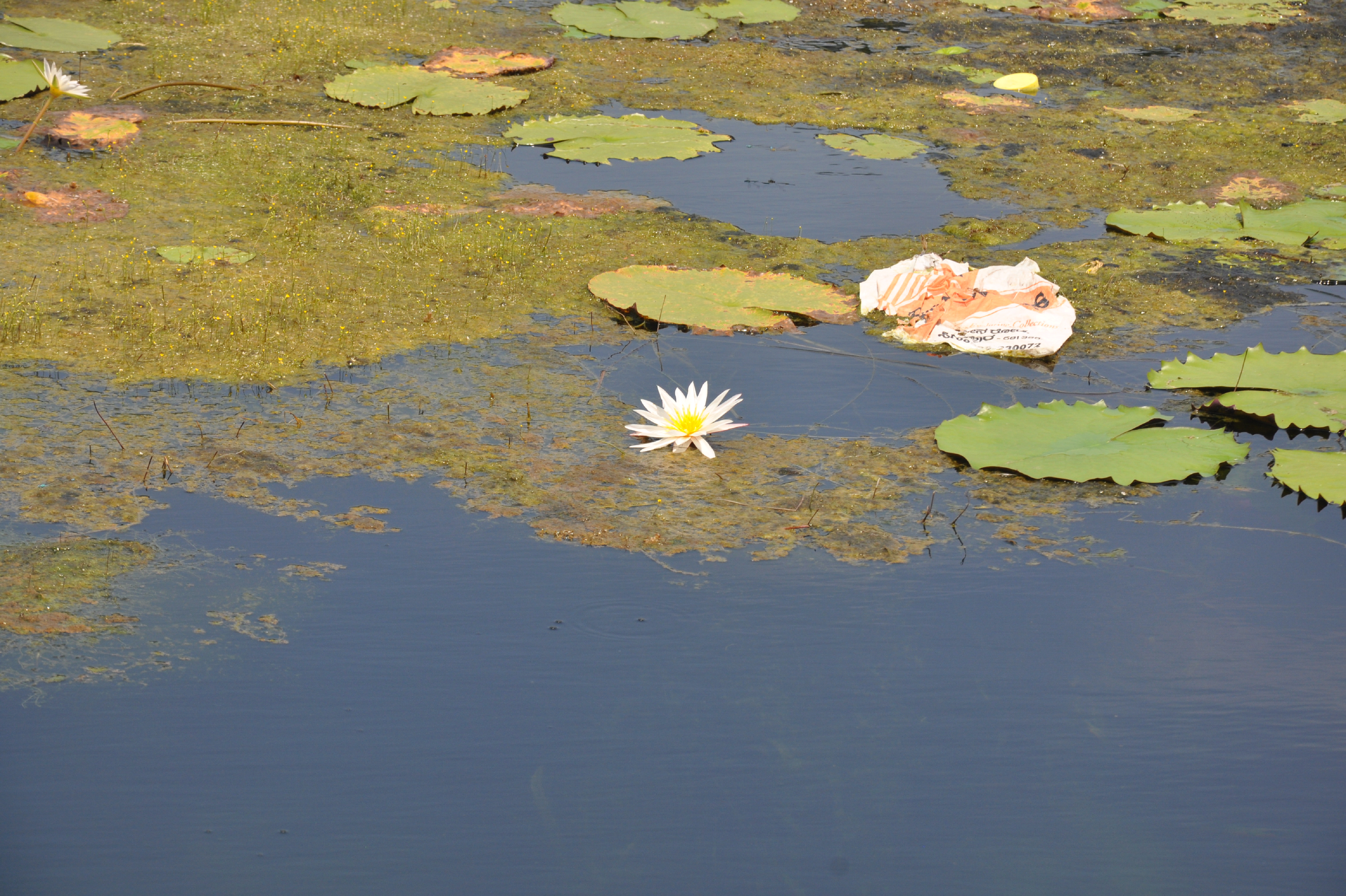
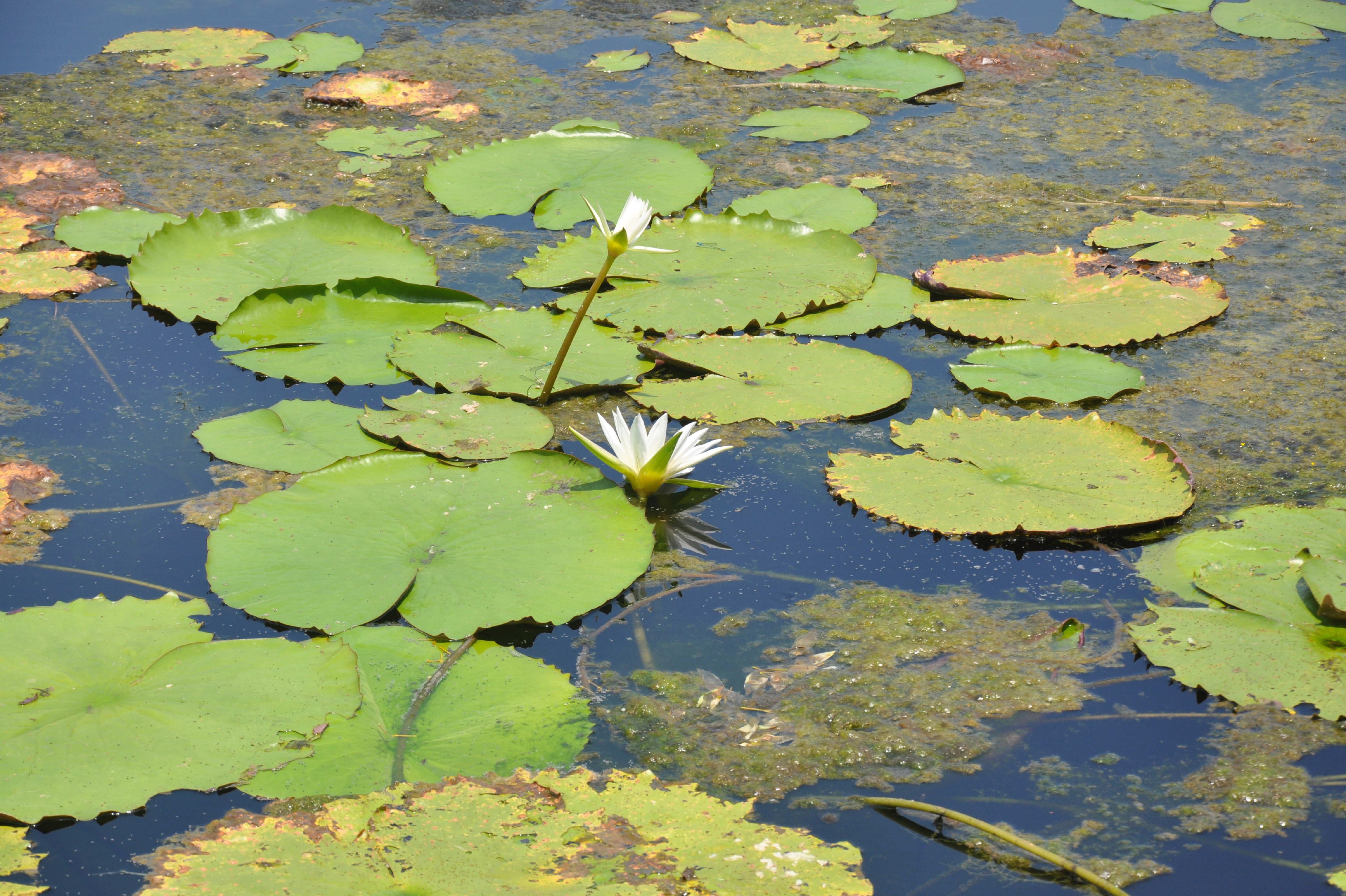
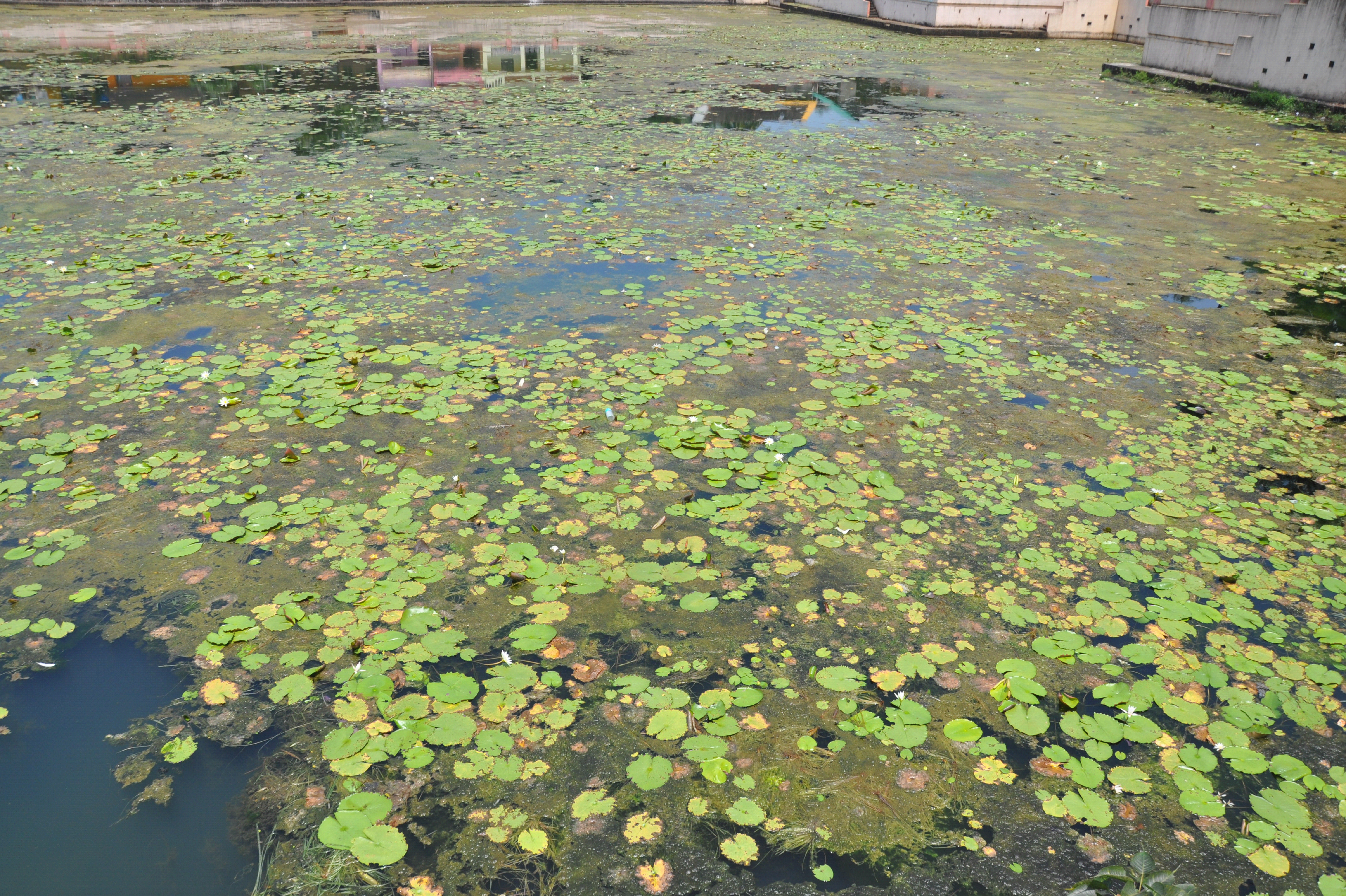
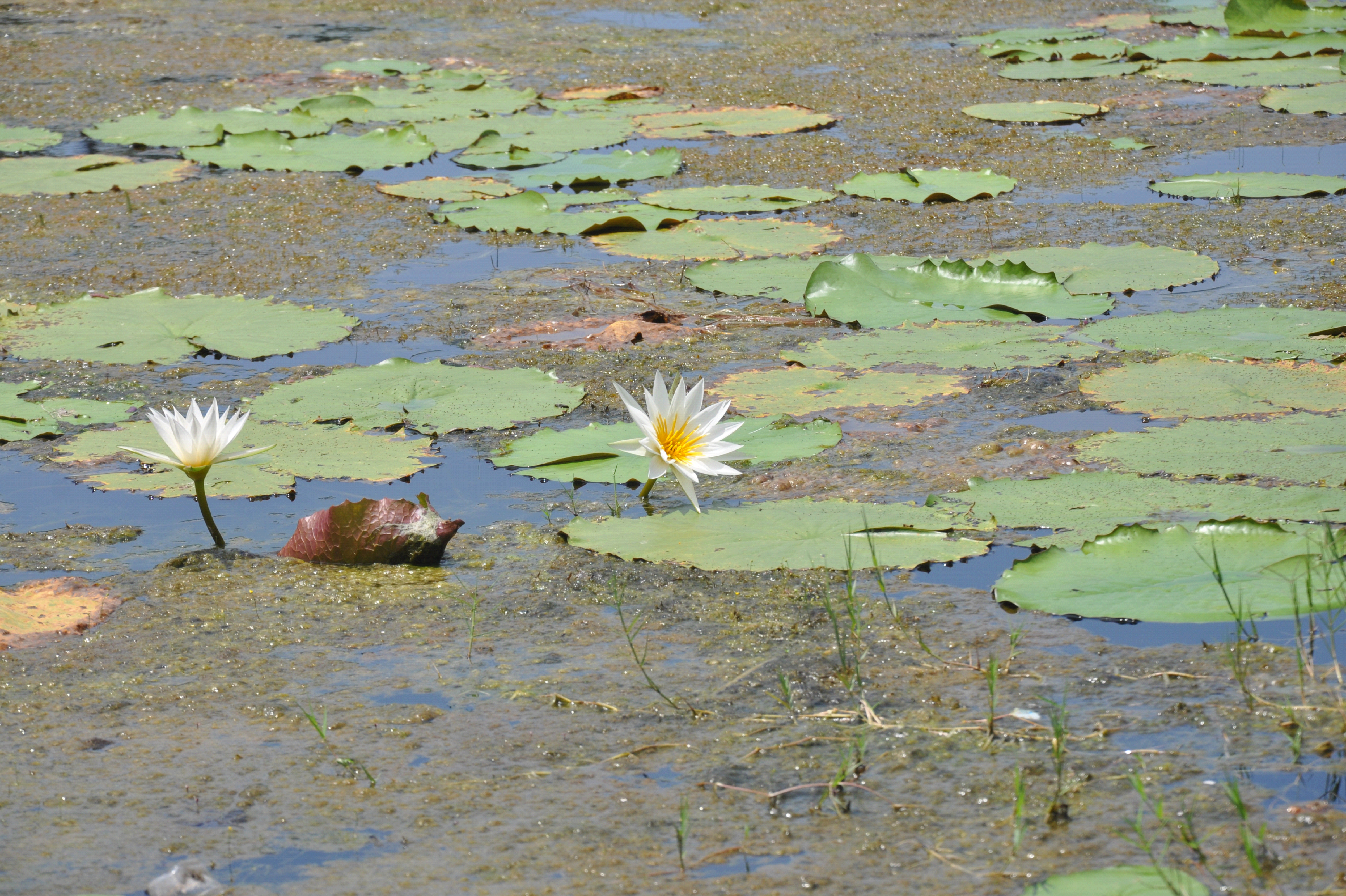
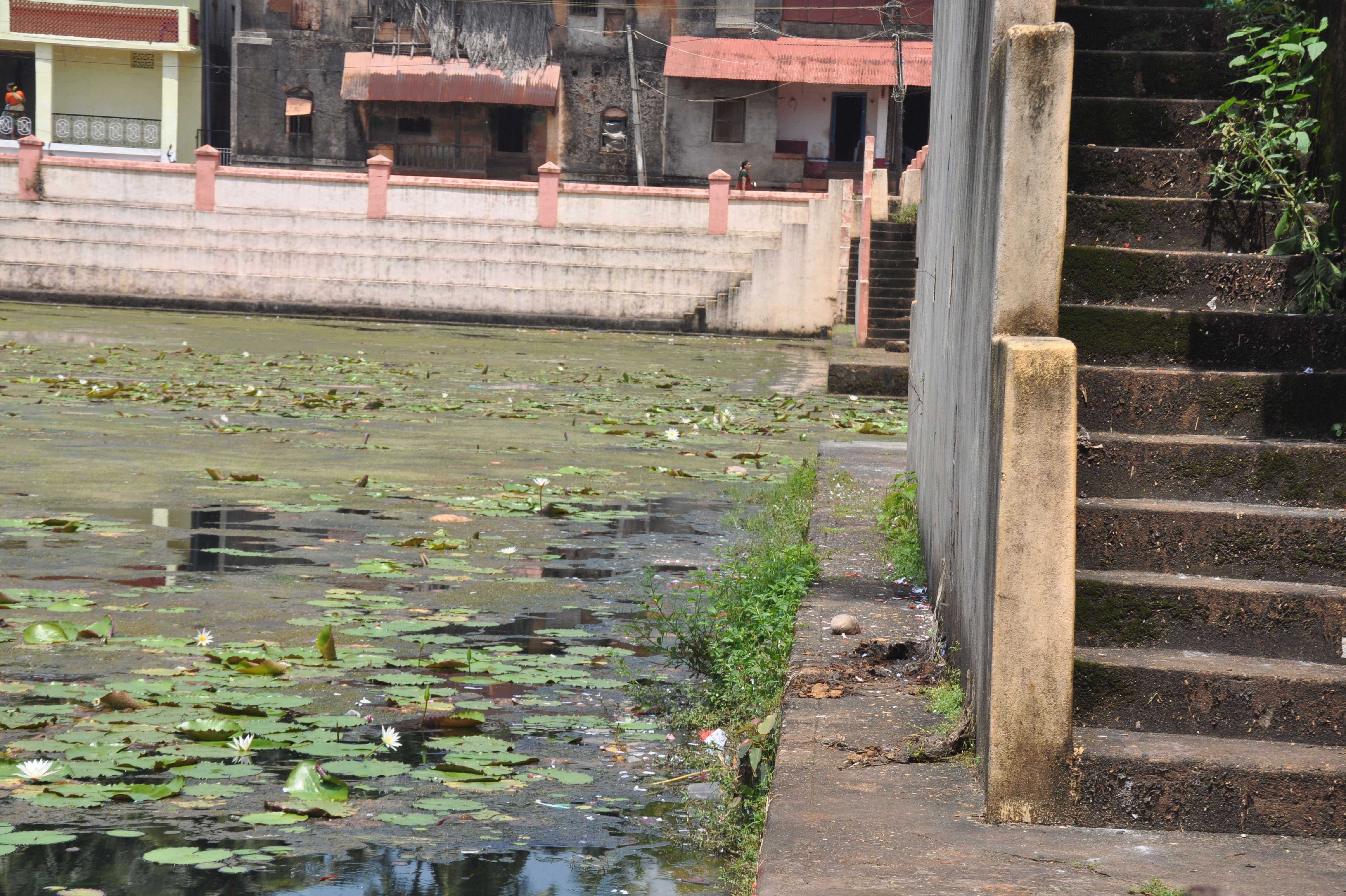
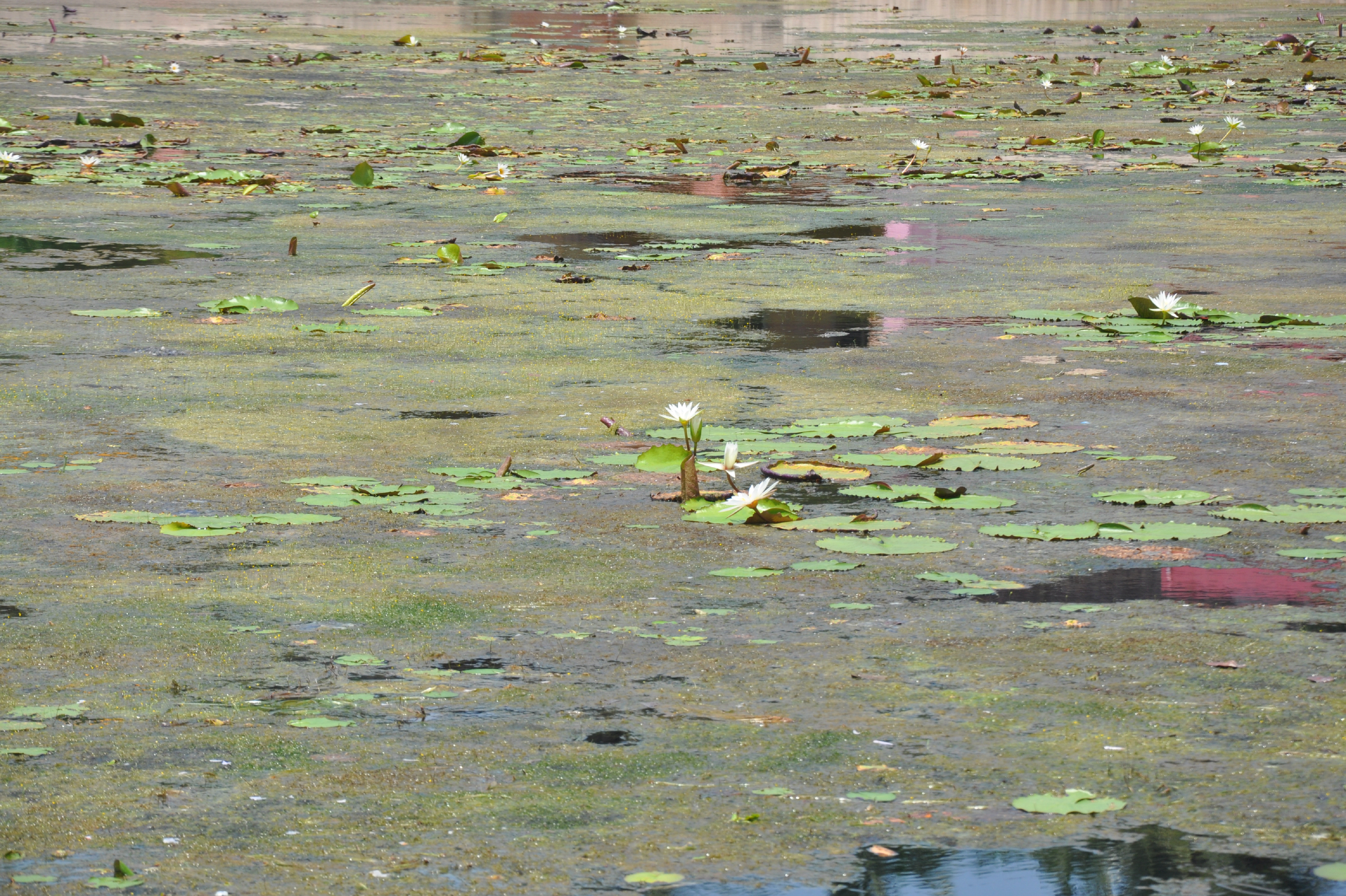
Figure 3.7: Network of filamentous algae with macrophytes trapping organics
High percentage composition of Cyanophyceae is indicative of eutrophic water (Lund 1965). Percentage contribution of Cyanophyceae in Kotiteertha pond shows that the nutrient levels are low and this could be an oligotrophic state. Dominance of algal genera like Euglena, Navicula, Nitzschia, Microcystis, Oscillatoria and Scenedesmus are indicative of organically pollution in waters, supported (Palmer, 1969). However the present study recorded abundant Oscillatoria members indicative of organic pollution. The epiphytic and epilithic algae may form excellent indicators of water pollution (Vyas and Kumar, 1968). In the present study the occurrence of spirogyra (mostly epilithic) and Oscillatoria (mostly epiphytic) were observed. Ramachandra et al., 2015 reported that Microcystis aeruginosa can be used as the best single indicator of pollution. However in the present study Microcystis sp. were not observed.
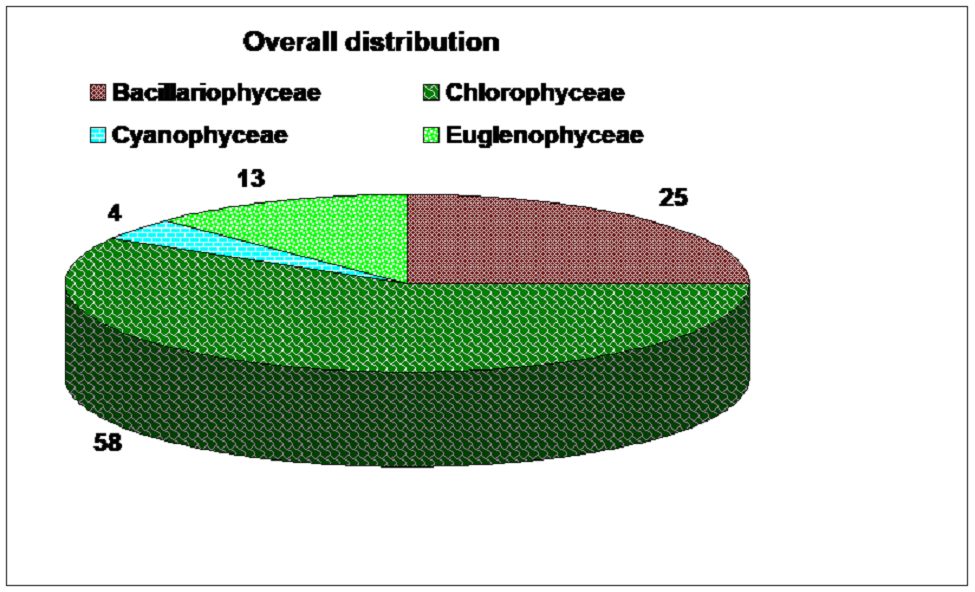
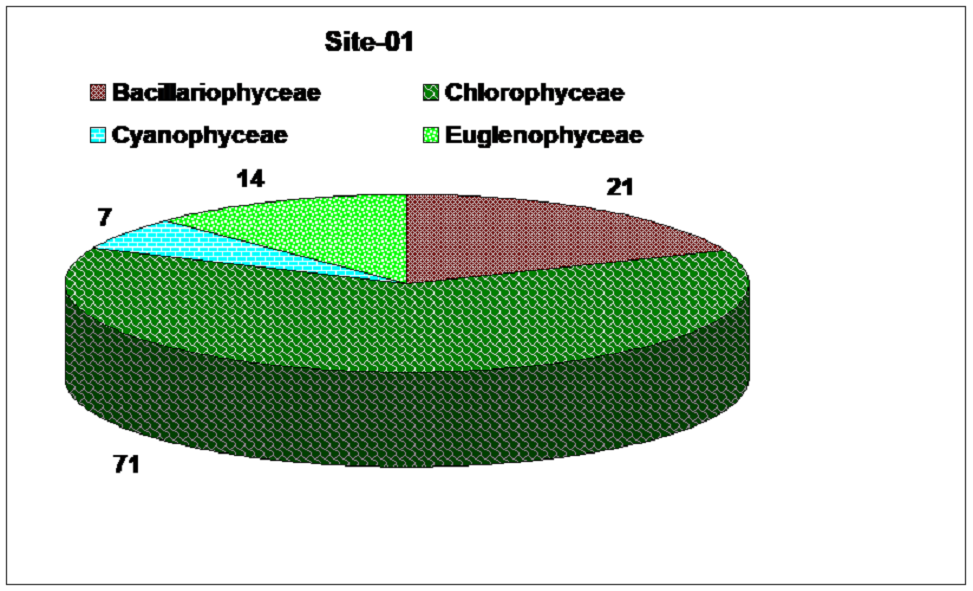
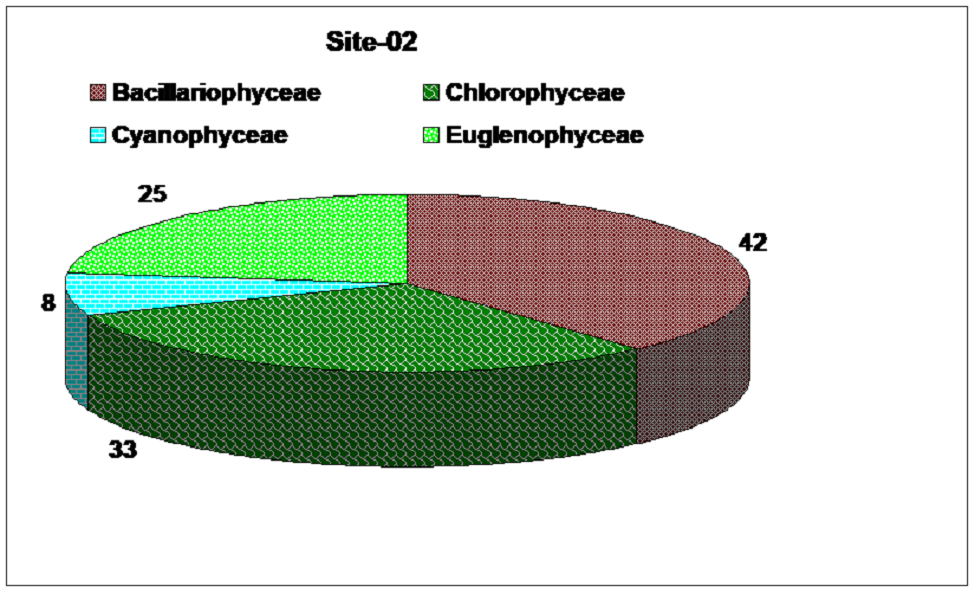
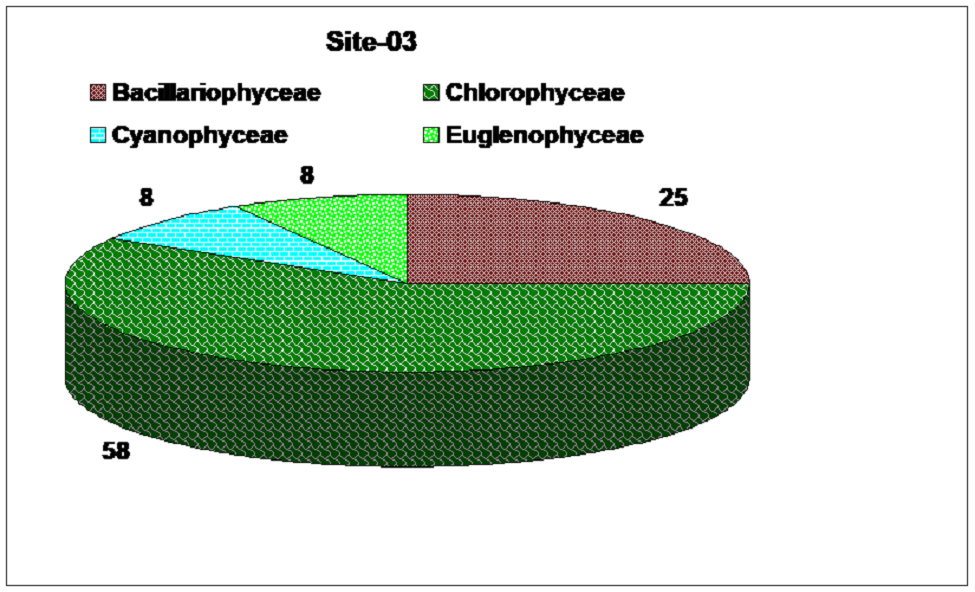
Figure 3.8: Algal composition a) Overall, b) Site 1, c) Site 2 and d) Site 3
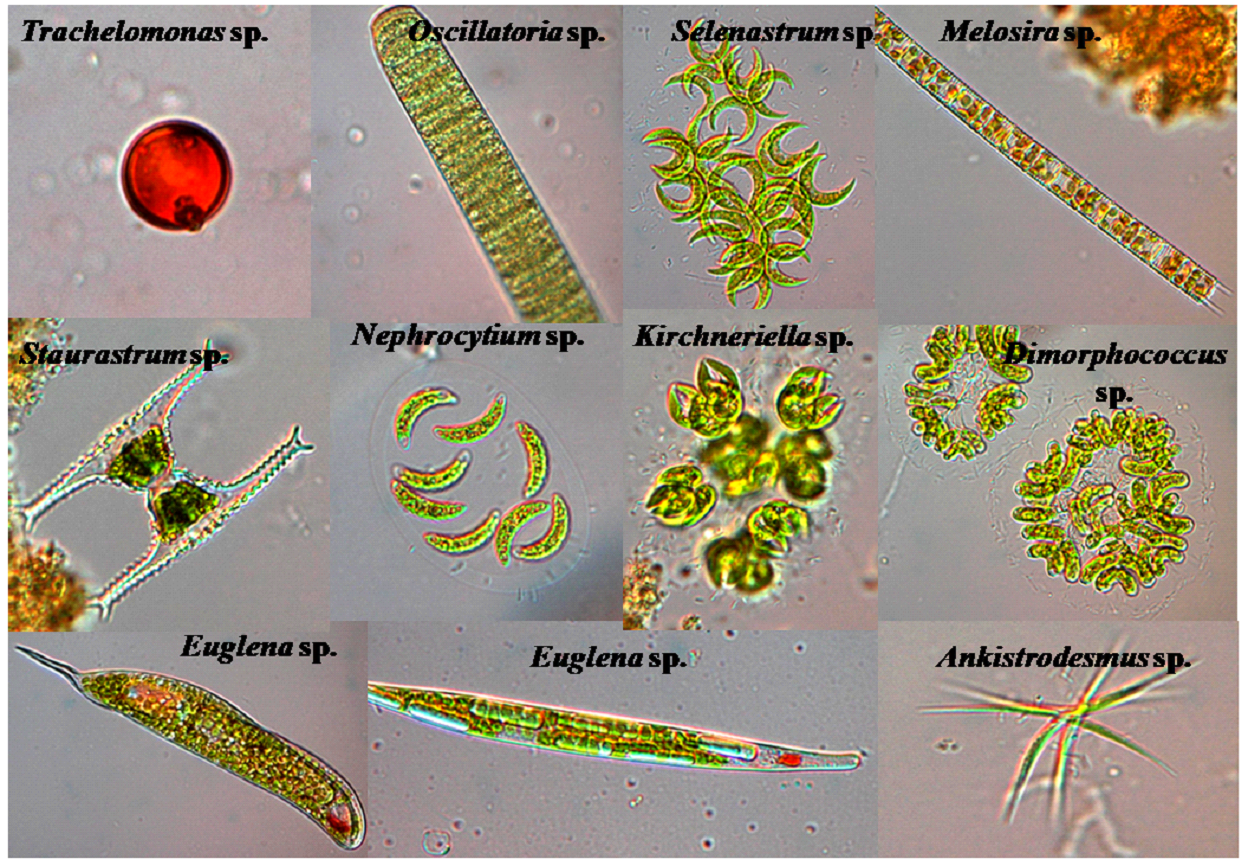
Figure 3.9: Microscopic images of some selected algae found in various sites of the temple pond
Table 3.3: Algal species of Gokarna temple pond, Kotiteertha
Sl no. |
Phytoplankton |
Sites |
||
I |
Chlorophyceae |
S1 |
S2 |
S3 |
1 |
Ankistrodesmus sp. |
+ |
- |
+ |
2 |
Coelastrum sp. |
- |
- |
+ |
3 |
Cosmarium spp. |
++ |
++ |
+ |
4 |
Dimorphococcus sp. |
+ |
- |
- |
5 |
Gloeocystis sp. |
+ |
- |
- |
6 |
Kirchneriella spp. |
++ |
- |
+ |
7 |
Nephrocytium sp. |
+ |
- |
- |
8 |
Pleurotaenium sp. |
- |
- |
+ |
9 |
Scenedesmus sp. |
- |
+ |
- |
10 |
Selenastrum sp. |
+ |
- |
- |
11 |
Staurastrum spp. |
++ |
++ |
+ |
12 |
Staurodesmus sp. |
+ |
- |
- |
13 |
Westella sp. |
+ |
+ |
- |
14 |
Xanthidium spp. |
- |
- |
++ |
II |
Cyanophyceae |
|||
1 |
Oscillatoria sp. |
+ |
+ |
+ |
III |
Euglenophyceae |
|||
1 |
Euglena sp. |
+ |
+ |
- |
2 |
Phacus sp. |
+ |
+ |
- |
3 |
Trachelomonas sp. |
- |
+ |
+ |
IV |
Bacillariophyceae |
|||
1 |
Fragilaria sp. |
- |
+ |
- |
2 |
Gomphonema sp. |
+ |
+ |
+ |
3 |
Melosira sp. |
+ |
+ |
- |
4 |
Navicula sp. |
- |
- |
+ |
5 |
Nitzschia sp. |
+ |
+ |
- |
6 |
Pinnularia spp. |
- |
+ |
+ |
- RECOMMENDATIONS
Field investigation, water and biological sample collection and analyses reveal of higher nutrient levels, signifying more cultural pressure due to (i) disposal of organic materials (flowers, rice balls, linseed, banana, curd, ghee, etc.) after performing rituals, (ii) bathing of large number of devotees, (iii) washing of cloth with detergents, (iv) disposal of solid waste and (iv) washing of utensils, etc. The algal diversity analyses show the proliferation of filamentous cyanophycean members and minimal suspended algae. Higher biomass growth, productivity and spread of aquatic plants Vallisneria spiralis, Nymphae nouchali, followed by Certophyllum demersum and Blyxa species highlight of nutrient enrichment. The overgrowth of such species triggers internal nutrient loading leading to further enrichment and subsequent deterioration of water quality. Therefore following action plans are recommended to regain the sanctity of the pond and to ensure pristine water in the surrounding wells.
REGULAR MAINTENANCE:
- Regular partial removal of water plants (kale) twice a year: at least before (a) Ganesha / vinayaka Chaturthi (b) Shivaratri - water plants to be removed by uprooting (about 60% - not complete removal). A community program for regular harvesting of pond macrophytes mostly the floating macrophytes will ensure adequate sunlight penetration that is helpful for the growth of phytoplankton's and submerged macrophytes and also helps in decontamination through destruction of pathogens i.e. harmful bacteria. Moreover free pond surface is highly required for gaseous exchange and diffusion of oxygen into the pond systems that is essential for the survival of pond biota like fishes.
- De-silting and sludge removal of the pond once in 5 years during the dry periods will help in checking the sedimentary P deposition and P flux that buffers the phosphate levels in the overlaying water.
REGULAR MONITORING
- Regular water quality monitoring by involving school and college students (co-ordinated by the regional centre of the Karnataka State Pollution Control Board)
- Setting up eco-clubs in the education institutions (as per the provisions available with the Karnataka State Pollution Control Board) in the local education institutions (schools and colleges)
- Regular maintenance of the pond (through cost effective ecological methods) involving local NGO's, NSS volunteers, students from schools and colleges - Mandatory Shramdhan for removal of silt as well as partial removal of water plants (kale)
- Safeguard cultural heritage through the community awareness programmes (street play, painting competition among school kids, essay and debate competition among college students, cultural programmes, etc.)
SUSTAINABLE MANAGEMENT:
- 'HERITAGE TOWN' status to GOKARNA considering the cultural heritage of the region. This entails environment management focussing on waste management, prevention of littering on roads, construction of public toilets (pay and use), construction of community bathrooms, arrangements for disposal of organic fraction (flowers, rice balls-pinda, grains, banana, etc.) of pithru karma rituals. Alternate arrangements for disposal of these organic wastes (flower, rice balls, etc.) and an arrangements to transfer these organic constituents to goshala (cattleshed). This could provide nourishment and also serving to milking cattle could be the best option of offering to the lord.
- Management of watershed - arrest deforestation -Planting of natives species in the catchment /watershed. This could be implemented by introducing the mandatory plant native sapling by the devotees performing rituals (with a nominal fee to cover the sapling cost).
- Celebration of the World Environment Day on June 5th, every year through large scale afforestation programme involving NSS volunteers, devotees visiting the temple (on June 5th), students (from nearby schools and gurukula) and local NGO's.
- Provision of wetlands at the entry of the pond (which will remove the contaminants entering the pond) during run-off
- Implement bio-manipulation (Labeo rohita and Catla catla- surface phytoplankton feeders, Rohu - Column zooplankton feeder, Gambusia and Guppies - larvivorous fishes for mosquito control, bottom dwellers - common carp, scavenging fish - Labeo fimbriatus).
- Restrictions on the disposal of organic matter (flowers, rice balls -pinda, grains, etc.).
- Introduce ducks (at least four pairs to begin with), which will aid in aeration and control of water plants, algae, etc. Introduction of water fouls (such as duck and coots) will also help in regulating the macrophytes to lower extent and at the same time providing surface aeration. This will activate the food web in the pond and will ensure recycle of the nutrients across the food chain.
- Plug cracks and other defects in the pond embankments. Timely management of the cracks and the fractures of the embankments will help in stopping waste water entering the pond.
- Restrictions on the disposal of organic matter (flowers, rice balls -pinda, grains, etc.) after rituals of pithru karma.
- Construction of 'PINDA KALYANI' - Alternate arrangements for disposal of organic wastes (flower, rice balls) and an arrangements to transfer to goshala (cattle shed). This could provide nourishment and also serving to milking cattle could be the best option of offering to the lord.
- Awareness among priests about the need for environment friendly option of disposal of organic materials of the ritual (as contaminating the pond water would also contaminate the nearby groundwater sources - bore well, open wells, etc.).
- As this pond is also used in the temple, restrictions on the use of pond for bathing by the community visiting the temple. Appropriate signage to this effect, would help in controlling the pollutants entering the pond.
- Only the head priest performing pooja to the deities at Gokarna be allowed to take bath (without synthetic soap).
- Ban on washing of cloth and utensils in the pond.
- Deployment of NSS volunteers and Local NGO's in raising the awareness among the public.
- Environment friendly Ganesha festival celebration in the temple or use of silver Ganesha / Pancha loha idols and worship at home.
- Complete ban on immersion of idols (painted, plaster of paris idols, etc.) in the pond. This will help in avoiding the influx of heavy metals and other contaminants getting into the temple pond.
- Environmental awareness among the local residents about the need to protect water bodies (at least keeping the next generation in mind).
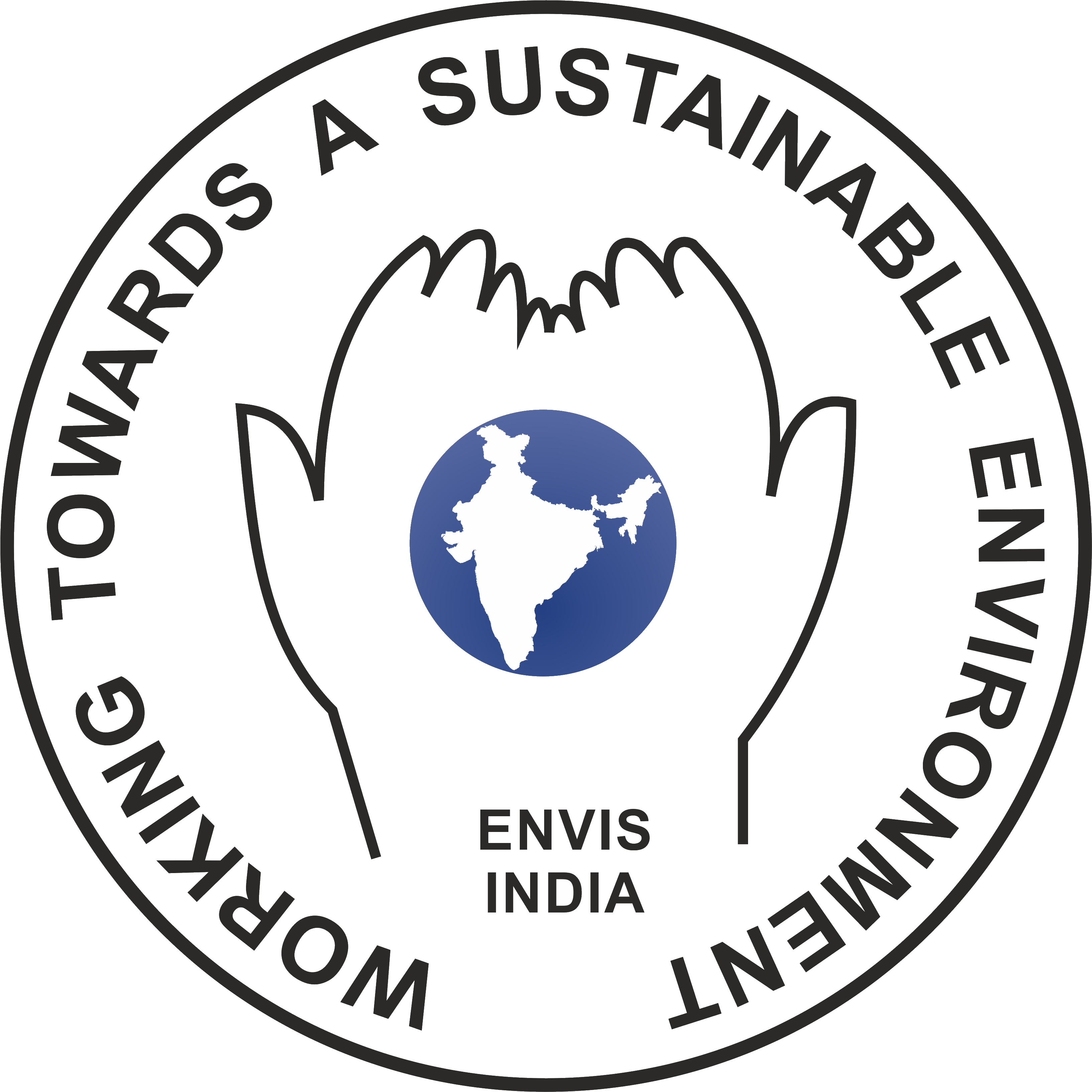

 Sahyadri ENews Issues: I - LXXVIII
Sahyadri ENews Issues: I - LXXVIII
